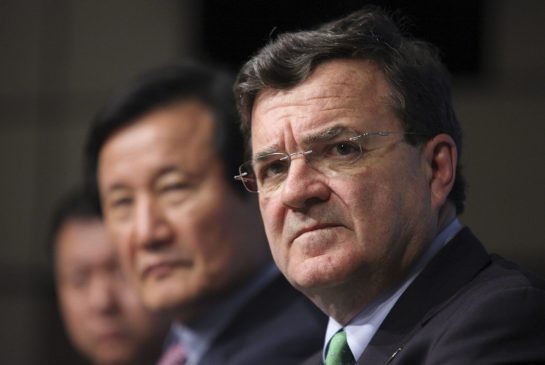
Waiting for pension reform across Canada is like watching paint dry: It takes forever and always needs another coat.
Now, after years of dabbling around the edges, Ontario is planning a few bold brushstrokes of its own: Frustrated by federal foot-dragging, the province is sketching out a plan for a supplementary Ontario Pension Plan.
The announcement could come early next month in the closely watched Fall Economic Statement to be delivered by Finance Minister Charles Sousa.
This article was published by The Toronto Star on October 16th, 2013. To see this article and other related articles on their website, please click here
Details remain sketchy: No word yet on who would manage a potentially massive Ontario fund, the contribution levels, or whether to make it compulsory.
“This is a big piece of work,” said one government official, in an actuarial understatement.
It’s also something of a gambit — because the embryonic plan may never see the light of day. The surprise strategy appears to be an attempt to warn Ottawa and the other provinces that Queen’s Park has run out of patience with delays and dithering on national pension reform.
Ontario’s first choice is still to jump-start long-delayed negotiations to reform the outdated Canada Pension Plan. Queen’s Park has long pressed for higher contribution levels by middle-class workers, arguing that the CPP lags behind most major industrialized countries in promised benefits.
Put another way, Ontario’s latest ultimatum is a form of positioning: If not a sweetened CPP, a separate OPP to supplement it.
Ontario’s next move depends on its recalcitrant negotiating partners. But it is clearly hoping to use its latest threat of unilateralism as a form of leverage to extract concessions on the CPP.
In Ottawa, Finance Minister Jim Flaherty has ragged the puck since Ontario tried to place pensions on the national agenda — skipping meetings, missing deadlines, ignoring provincial proposals. The federal Tories, echoing the concerns of big business, keep warning that economic recovery is too fragile to withstand any mandatory increases in contributions by both workers and employers to the CPP.
With Canada on the cusp of more robust growth in the years ahead, the excuses are wearing thin. At a time when traditional company pensions are rapidly disappearing, CPP benefits are capped at roughly $12,000 annually — leaving middle-class earners exposed in their retirement years.
That’s why pensions are a sleeper issue in Canada. As voters feel more vulnerable, they may wake up to the collective inaction of their political leaders.
At their last meeting on pension reform in late 2012, federal and provincial finance ministers agreed to map out new signposts for economic growth that could allow for “modest” increases to CPP contributions in future. At the time, I wrote about a confidential 30-page discussion paper prepared by federal officials showing how it could be done. The politicians pledged to meet again this past summer, but Flaherty refused to reconvene on pensions.
Against that backdrop, Premier Kathleen Wynne hosted her provincial counterparts at the annual premiers’ meeting in Niagara-on-the-Lake last July, where they reached agreement in principle to maintain a united front on CPP enhancements. But the details of any common agreement remain elusive.
The Canadian Labour Congress and most major unions have long sought a doubling of CPP payouts. In recent weeks, Prince Edward Island has also proposed increases to benefit workers earning more than $50,000 a year (under the current CPP, any income above that amount is not counted, which explains why benefits remain relatively low).
Next week, Wynne heads out on a western swing to press her case with Alberta Premier Alison Redford and Manitoba’s Greg Selinger. As a Red Tory, Redford may be more open to CPP enhancements than her predecessors, who shared Flaherty’s reticence. As Canada’s last remaining NDP premier, Selinger supports a stronger CPP.
But the negotiating timeline is tight.
On Nov. 1, provincial finance ministers will meet in Toronto, where Sousa is expected to bring in a more specific position from Ontario. The hope is to set the table for a follow-up meeting by the premiers two weeks later, hosted by Wynne.
If she can maintain the pension momentum, Ontario would try to organize a strong push with its newfound provincial allies in time for the scheduled December meeting between Flaherty and his fellow finance ministers.
Either way, Ontario will be on the spot next month. Wynne and her finance minister will have to decide on the direction of their Fall Economic Statement:
Is there enough momentum for a pan-Canadian deal on an enhanced CPP? Or are we facing yet another dead end on pension reform, requiring Ontario to create its own supplementary pension plan?
The idea of a separate provincial pension fund isn’t entirely new. Quebec runs its own QPP, although it is largely modelled on the CPP (and its investments haven’t done as well lately, requiring the province to boost contribution rates).
NDP Leader Andrea Horwath proposed a supplementary Ontario pension in early 2010 that would pay $700 a month to the six in 10 people without a workplace plan. At the time, the Liberal government didn’t bite, insisting that a national pension summit would produce better results.
No national summit ever materialized. Four years later, still waiting for the paint to dry on pension reform, Ontario is going back to the drawing board. And, belatedly, preparing its own supplementary plan.
Unable to bank on a CPP breakthrough, the province is hedging its bets with an OPP backstop.
